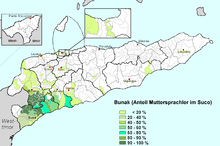Bunak language
The Bunak language (also known as Bunaq, Buna', Bunake, pronounced [bunaʔ]) is the language of the Bunak people of the mountainous region of central Timor, split between the political boundary between West Timor, Indonesia, particularly in Lamaknen District and East Timor. It is one of the few on Timor which is not an Austronesian language, but rather a Papuan language, presumably belonging to the Trans–New Guinea language family. The language is surrounded by Malayo-Polynesian languages, like Uab Meto and Tetum.
| Bunak | |
|---|---|
| Native to | Indonesia, East Timor |
| Region | central Timor |
| Ethnicity | Bunak |
Native speakers | 76,000 (2010)[1] |
Trans–New Guinea
| |
| Language codes | |
| ISO 639-3 | bfn |
| Glottolog | buna1278[3] |
 Distribution of Bunak in East Timor (West Timor not shown) | |
Bunak distinguishes between animate and inanimate noun classes.[4]
Pronouns
Pronouns seem to tie Bunak more closely to the Alor–Pantar languages, in a group Ross (2005) calls "West Timor", than with the Papuan East Timor languages. The independent pronouns and object prefixes, which appear to retain the proto-Trans–New Guinea dual suffix *-li, are as follows:
sg du pl 1excl ne-to
n-ne-li
n-ne-i
n-1incl i-li
∅-i
∅-2 e-to
∅-e-li
∅-e-i
∅-3an himo
g-– hala'i
g-3inan homo
References
- Bunak at Ethnologue (18th ed., 2015)
- New Guinea World, West Bomberai
- Hammarström, Harald; Forkel, Robert; Haspelmath, Martin, eds. (2017). "Bunak". Glottolog 3.0. Jena, Germany: Max Planck Institute for the Science of Human History.
- Holton, Gary; Klamer, Marian (2018). "The Papuan languages of East Nusantara and the Bird's Head". In Palmer, Bill (ed.). The Languages and Linguistics of the New Guinea Area: A Comprehensive Guide. The World of Linguistics. 4. Berlin: De Gruyter Mouton. pp. 569–640. ISBN 978-3-11-028642-7.
- Schapper, Antoinette (2009). Bunaq: a Papuan language of central Timor (Ph.D. thesis). doi:10.25911/5d611d87406d0. hdl:1885/150147.CS1 maint: ref=harv (link)
- Schapper, Antoinette (2011a). "Crossing the border: Historical and linguistic divides among the Bunaq in central Timor". Wacana, Journal of the Humanities of Indonesia. 13 (1): 29–49. doi:10.17510/wjhi.v13i1.8.CS1 maint: ref=harv (link)
- Schapper, Antoinette (2011b). "Finding Bunaq: The homeland and expansion of the Bunaq in central Timor". In McWilliam, Andrew; Traube, Elizabeth G. (eds.). Land and Life in Timor-Leste: Ethnographic Essays. ANU Press. doi:10.22459/lltl.12.2011.08. ISBN 978-1-921862-59-5.CS1 maint: ref=harv (link)
External links
- ELAR archive of Zapal, an oral literature genre of the Bunaq Lamaknen
- Timothy Usher, New Guinea World, Bunaq